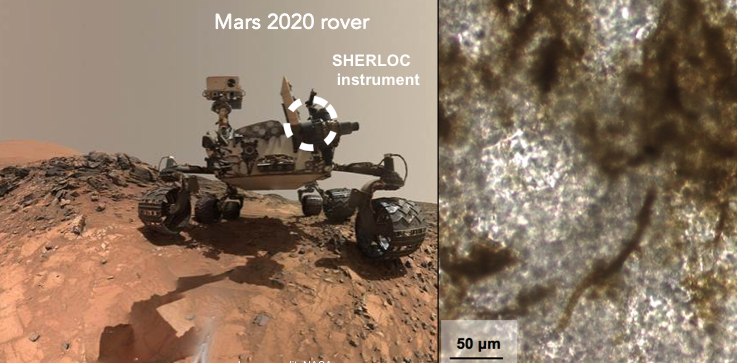-
Supporting SHERLOC in the Detection of Kerogen as a Biosignature
July 06, 2018 / Posted by: Miki Huynh
Left: SHERLOC will be mounted on the arm of the Mars 2020 rover. Image source: NASA. Right: Stromatolitic limestone as a Mars analog sample containing kerogen (dark regions) as a complex fossil biosignature, hosted by carbonate (light regions), which was successfully detected by UV Raman and fluorescence spectroscopy in this study. Image source: S. Shkolyar / J. Farmer.The upcoming Mars 2020 rover mission will hunt for signs of past microbial life and indications of habitable conditions on Mars. A device mounted on the rover’s arm, called SHERLOC (Scanning Habitable Environments with Raman & Luminescence for Organics & Chemicals), will aid in the detection of kerogens, fossilized organic materials in sedimentary rocks.
To inform NASA’s planning strategies for SHERLOC, Svetlana Shkolyar, a 2014 recipient of the NASA Astrobiology Early Career Collaboration Award, and her research team analyzed the capabilities of co-located time-gated Raman and fluorescent spectroscopy in detecting and distinguishing kerogen when scanning Mars analogue samples.
The team’s findings, published in Astrobiology reveal promising results and highlight the value of combining co-located Raman and fluorescence spectroscopies, similar to those obtainable by SHERLOC, to strengthen the confidence of kerogen detection as a potential biosignature in complex samples.
Source: [Astrobiology (via SETI Institute)]
- The NASA Astrobiology Institute Concludes Its 20-year Tenure
- Global Geomorphologic Map of Titan
- Molecular Cousins Discovered on Titan
- Interdisciplinary Consortia for Astrobiology Research (ICAR)
- The NASA Astrobiology Science Forum Talks Now on YouTube
- The NASA Astrobiology Science Forum: The Origin, Evolution, Distribution and Future of Astrobiology
- Alternative Earths
- Drilling for Rock-Powered Life
- Imagining a Living Universe
- Workshops Without Walls: Astrovirology